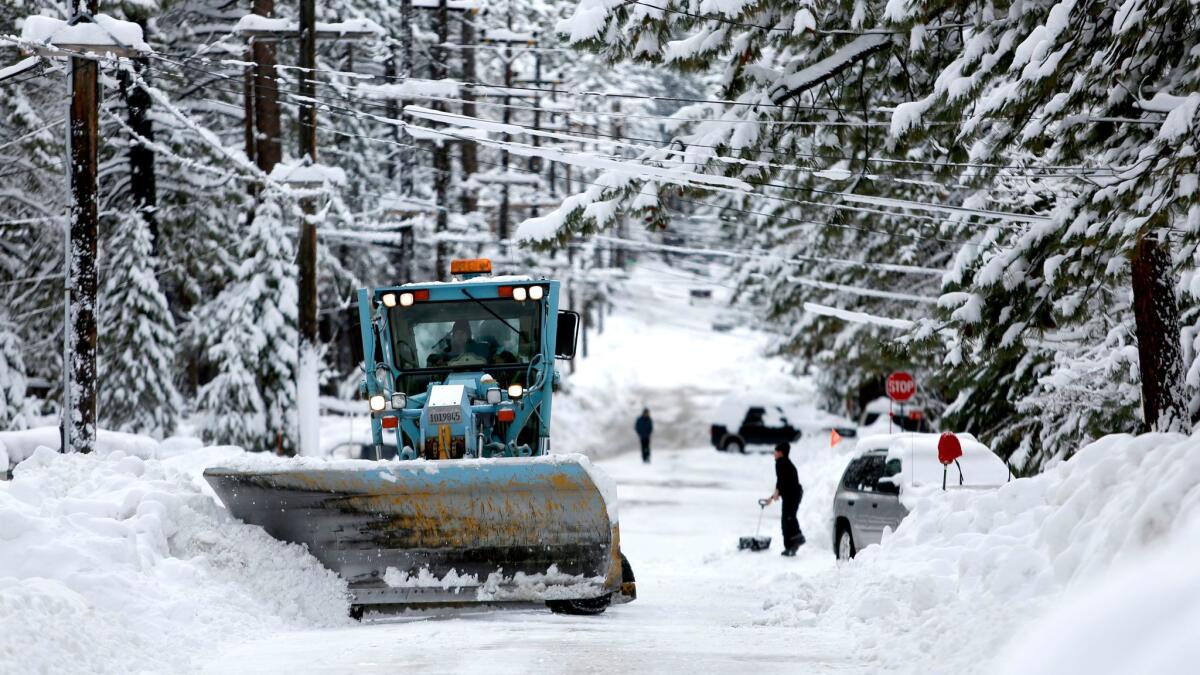California snowpack reaches 173% of average, replenishing a third of state’s ‘snow-deficit’
- Share via
Snowfall from a series of blizzard-like storms that blanketed the Sierra Nevada last month deposited the equivalent of more than 5.7 trillion gallons of water along the rugged mountain range — enough water to fill California’s largest reservoir more than four times, according to recent analysis.
In a study by the University of Colorado Boulder and NASA’s Jet Propulsion Laboratory, in La Cañada Flintridge, scientists concluded this month that recent snowfall had replenished more than a third of the state’s lingering “snow-water deficit.”
The finding comes as the California Department of Water Resources released its latest snow survey results on Thursday. Thanks largely to a series of atmospheric rivers that ferried large amounts of tropical moisture to the parched West Coast, Sierra Nevada snowpack has now reached 173% of average.
Snow accumulation this year stands in sharp contrast to that of the previous five years — a period when much of the state was struggling through drought.
In order to determine how much less snow the Sierra experienced during that time, researchers used satellite and ground sensor data to calculate the size of seasonal snowpack and compared it with the historical average. What they found was that the Sierra Nevada collected about 17 trillion gallons less water than if the years had normal snowfall.
January’s storms, however, replenished more than a third of that deficit, according to researchers. They, along with storms in the previous months, succeeded in removing about half the state from lingering drought conditions by filling reservoirs and raising Sierra snowpack to rooftop levels, according to the U.S. Drought Report.
But even though the rain and snow totals are eye-popping, their long-term impact on the drought remains far from clear, according to Jay Lund, director of the Center for Watershed Sciences at UC Davis, who was not involved in the study.
Over the last five years, numerous cities have turned to underground wells and basins for water. Exactly how much water has been pumped out over the years — and how much remains — is unknown, water officials say.
“That’s where the deficit is really concentrated. Every time [consumers] didn’t have enough water, they pumped,” Lund said.
DWR officials acknowledge that California’s groundwater hasn’t been tracked as far back in time, or in as much detail, as the state’s surface reservoirs and snowpack. In fact, officials may never arrive at an accurate measure.
“First of all, groundwater is pretty hard to estimate volume for. It’s buried,” Lund said. “It varies with the local geology. And if you want to ask how much is the total volume underground – how deep do you want to go?”
In many cases, consumers have pumped water from groundwater basins much faster than Mother Nature can replenish the stuff — a phenomenon that has caused the ground level in parts of California to sink.
A 2015 A NASA report showed that groundwater pumping has caused land in some parts of the San Joaquin Valley to subside at an alarming rate.
Researchers say that when this winter’s snow begins to melt later in the year, the runoff will help replenish localized groundwater and aquifers along river channels and floodplains. However, other parts of the state hit hard by drought won’t reap the same benefits.

“It is important to realize that any aquifer recharge that occurs as a result of this winter’s storms is just a small uptick in a century-long decline of groundwater storage, at least with respect to the once-vast reserves in the Central Valley,” said James Famiglietti, a senior water scientist at JPL. “The drought may be easing, but California’s chronic water scarcity is here to stay.”
The study was produced by JPL and the University of Colorado’s Center for Water Earth Science and Technology, and tapped NASA’s satellites to measure the Sierra Nevada snowpack, which turns into a third of California’s water supply when it melts in the spring and summer.
For breaking California news, follow @JosephSerna on Twitter.
ALSO
Is the great California drought finally ending?
What all those dead trees mean for the Sierra Nevada
How California went from drought to dangerous rain and snow
More to Read
Sign up for Essential California
The most important California stories and recommendations in your inbox every morning.
You may occasionally receive promotional content from the Los Angeles Times.














